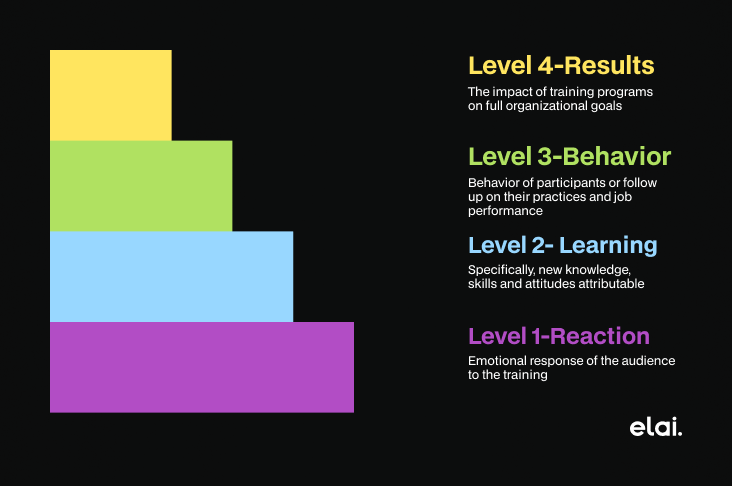Donald Kirkpatrick’s Four Levels of Training Evaluation is a prominent framework for assessing training efficacy and applicability. This model, originally developed in the 1950s and later improved, is now the most extensively used method for evaluating both new and current training initiatives in a number of industries. This article describes each level and its typical objectives in detail and how to apply them to maximize learning effectiveness in video-based learning.

Level 1: Reaction
At the first level, Kirkpatrick’s evaluation model focuses on the audience’s emotional response to the training. In other words, this level shows the degree of understanding, acceptance, and the overall mindset of learners. The easiest way to measure this is to ask several questions either immediately after the session or within several hours of its end. Usually, the questions refer to the quality and impact of the training, its relevancy, and its advantages for those who plan to go through it or already have. The discussion may be formal if it is based on a questionnaire, or informal if a leader simply asks the learners about their impressions.
Level 1 Evaluation serves several purposes:
- Quality Assessment: It helps training organizers understand what aspects of the training were well-received and which need improvement.
- Engagement and Relevance: Feedback indicates if participants were engaged and if the content resonated with their needs and expectations.
- Justification: It justifies the training investment by demonstrating participant satisfaction and perceived value.
Level 2: Learning
The second level of Kirkpatrick’s Four Level Evaluation Model gauges how much participants have learned from the training – specifically, new knowledge, skills, and attitudes attributable to having been trained. Unlike Level 1, this level assesses practical aspects of learning. One way to evaluate this is with the help of pre and post-training assessments that will give you a measure of knowledge gained and skill development. An evaluation of this type focuses on comparing the proficiency or performance level already possessed by participants before training with what they have learned due to that program.
Key objectives of Level 2 evaluation include:
- Knowledge Transfer: Determining the effectiveness of the training in imparting new information and skills.
- Skill Application: Assessing the practical application of learning in real-world scenarios.
- Content Effectiveness: Identifying areas where the training content may need adjustment to enhance learning outcomes.
Level 3: Behavior
Evaluate how much the participants apply what they have learned in their jobs. This higher level goes beyond mere knowledge transfer and now involves changing the behaviors and application of new skills on the job. You check if the training has impacted positively, the behavior of participants or follow up on their practices and job performance.
Facets of Level 3 evaluation:
- Behavior Change: Tracking what observable changes, if any occur in how participants go about handling tasks and challenges.
- Impact on Job Performance: Relating outcomes and performance metrics to learn.
- Solutions for Implementation Challenges: Strategies that target barriers to applying newly learned skills.
Level 4: Results
The last tier of Kirkpatrick’s model measures the impact of training programs on full organizational goals. It means the calculation of visible outcomes and ROI resulting from an investment in training. It could be seen in better productivity, the development of faster methods for delivering a service or product to customers, budget savings in the form of reduced time spent on developing training materials and courses with no platform mentoring associated costs, reduction of costliest errors made by an employee providing them insights into what many successful professionals have learned during their careers; more outputs being produced resulting directly from this structured coaching approach while retaining your best talents -any business metric influenced through training.
Level 4 evaluation involves:
- Return on Investment (ROI) Calculation – Inclusive of quantifying the financial (or operational for that matter) benefits achieved through a new technical infrastructure implementation.
- Outcomes – long-term: recognizing improvements and benefits that were sustained over time.
- Transparency: Forming a connection between training initiatives and organizations’ key performance indicators.
Applying the Kirkpatrick Model of Training Evaluation to Interactive Videos
For any L&D Specialist, it is crucial to create a Learning Product, the objectives of which are measurable. Consider the following tips to ensure effective evaluation and maximize learning outcomes of video courses:
Level 1: Reaction
- Interactive Engagement: When creating an interactive video, the most reliable way of ensuring its learners engage with it is to make sure that it is easy to engage with, so ensure the reason behind interactivity.
- Feedback Mechanism: Some of the ways of doing that include the use of feedback loops to have a better understanding of users’ perceptions and engage them. For example, they can be used at the end of the video, in the form of a short survey or a poll, to find out how relevant, clear, and useful the video has been.
- User Experience (UX): The interaction between the user interface with the UX and the design of the video is another important aspect of engaging. If the user is likely to not understand how to interact with video elements, this would reduce engagement.
Level 2: Learning
- Assessment Integration: Making sure that users learn what a video was intended to teach is possible with the help of interactive videos as well. The assessment of learning objectives is important in this process. Some ways that the assessment can be carried out is based on the use of quizzes, such as in-video quizzes, simulations, or decision-making interactive elements throughout the video.
- Progress Tracking: Their results could be shown either after all have been completed, together with the final score, or, most importantly, right after being made. It is also important to have some form of progress tracking in the video. This could be a course with the possibility to notice their progress, the number of videos left to watch; or checklists, icons, or points that the user will receive upon completing a section.
Level 3: Behavior
- Realistic Scenarios: To influence behavior, it is recommended to have realistic scenarios where the users could be asked to make decisions in their workplaces, where some of them will be allowed, or preferable, and some will not be. The details are important here, so the scenario should be based on the real data that has been described earlier in the video.
- Branching Pathways: Offer interactive assessments, where each one of the questions would have several possible decisions that could be made and each of them would lead to a different video on various circumstances depending on their correctness.
- Performance Metrics: The level of performance can be assessed using online quizzes, assessments, or supervisors, based on the performance of a user in the video.
Level 4: Results
- Long-term Evaluation: A long-term period assessment and a refresher video should also be made at some later time after the training has been implemented, trying to follow the patterns of reaching the hypothesized numbers verified by the “supervisor, self-assessment, or anything tied to a skill that was being trained”.
4 levels of training evaluation provide a structured approach to assessing the effectiveness of training programs at different stages: from immediate reactions and learning outcomes to behavioral changes and overall business impact. Organizations may measure the success of their training initiatives and make educated decisions to continuously enhance training content, delivery strategies, and overall effectiveness in accomplishing organizational goals by methodically evaluating each level. For training professionals looking to get the most out of their training investments, this model is still an essential tool.
Resources:
James D. Kirkpatrick, Wendy Kayser Kirkpatrick (2016) Kirkpatrick’s Four Levels of Training Evaluation. Association for Talent Development

